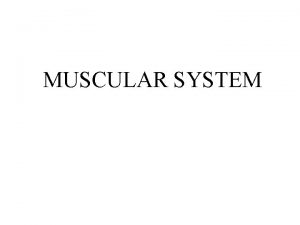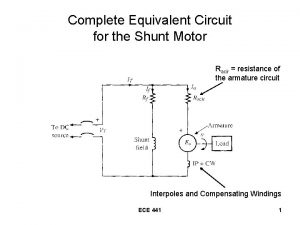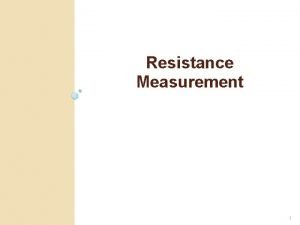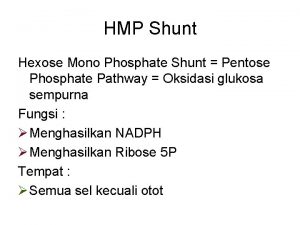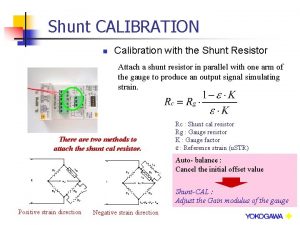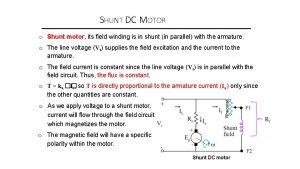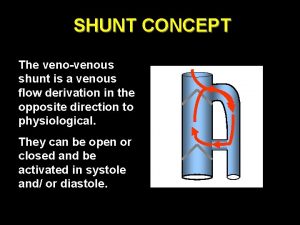l 1 EXTERNAL ARTERIOVENOUS SHUNT AV SHUNT l

















- Slides: 17

l 1

EXTERNAL ARTERIOVENOUS SHUNT (AV SHUNT) l DESCRIPTION l Access is formed by the surgical insertion of two Silastic cannulas into an artery and a vein in the forearm or leg to form an external blood path l The cannulas are connected to form a U-shape; blood flows from the patient’s artery through the shunt into the vein l A tube leading to the membrane compartment of the dialyzer is connected to the arterial 2 cannula

A-V Shunts 3

EXTERNAL ARTERIOVENOUS SHUNT (AV SHUNT)… l DESCRIPTION Blood fills the membrane compartment and flows back to the patient by way of a tube connected to the venous cannula l When dialysis is complete, the cannulas are clamped and reattached to form their U-shape l 4

ARTERIOVENOUS SHUNT 5

EXTERNAL ARTERIOVENOUS SHUNT (AV SHUNT) l ADVANTAGES Can be used immediately following creation l No venipuncture is necessary for dialysis l l DISADVANTAGES External danger of disconnecting or dislodging l Risk of hemorrhage, infection, or clotting l Skin erosion around the catheter site can occur l 6

EXTERNAL (AV SHUNT) l IMPLEMENTATION Avoid wetting the shunt l A dressing is completely wrapped around the shunt and kept dry and intact l Cannula clamps need to be available at the patient’s bedside l Do not take a blood pressure, draw blood, place an IV, or administer injections in the shunt extremity l Monitor for hemorrhage, infection, and clotting l 7

EXTERNAL (AV SHUNT)… l IMPLEMENTATION Monitor skin integrity around the insertion site l Note that the shunt is patent if it is warm to touch l Auscultate and palpate for a bruit, although a bruit may not be heard and is not always felt with the shunt l Notify the physician immediately if signs of clotting, hemorrhage, or infection occur l 8

EXTERNAL (AV SHUNT)… l SIGNS OF CLOTTING Fold back the dressing to expose the shunt tubing and assess for signs of clotting l Fibrin (white flecks) noted in the tubing l The separation of serum and cells l The absence of a previously heard bruit l Coolness of the tubing or extremity l patient complains of a tingling sensation l 9

INTERNAL ARTERIOVENOUS FISTULA (AV FISTULA) l DESCRIPTION Access of choice for chronic dialysis patients l Created surgically by anastomosis of an artery in the arm to a vein; this creates an opening or fistula between a large artery and a large vein l The flow of arterial blood into the venous system causes the veins to become engorged (matured or developed) l 10

INTERNAL ARTERIOVENOUS FISTULA (AV FISTULA)… l DESCRIPTION Maturity takes about 1 to 2 weeks and is required before the fistula can be used, so that the engorged vein can be punctured with a large-bore needle for the dialysis procedure l Subclavian or femoral catheters, peritoneal dialysis, or an external AV shunt can be used for dialysis while the fistula is maturing or developing l 11

ARTERIOVENOUS FISTULA 12

INTERNAL ARTERIOVENOUS FISTULA (AV FISTULA) l ADVANTAGES Since the fistula is internal, there is less danger of clotting and bleeding l The fistula can be used indefinitely l Decreased incidence of infection l No external dressing is required l Allows freedom of movement l 13

INTERNAL ARTERIOVENOUS FISTULA (AV FISTULA) l DISADVANTAGES l l l Cannot be used immediately after insertion Needle insertions are required for dialysis Infiltration of the needles during dialysis can occur and cause hematomas An aneurysm can form in the fistula Arterial steal syndrome can develop (too much blood is diverted to the vein and arterial perfusion to the hand is compromised) CHF can occur from the increased blood flow in the venous system 14

15

AV FISTULA AND AV GRAFT l IMPLEMENTATION l l Do not measure a blood pressure, draw blood, place an IV, or administer injections in the fistula or graft extremity Monitor for clotting: complaints of tingling or discomfort in the extremity or the inability to palpate a thrill or auscultate a bruit over the fistula or graft Monitor for arterial steal syndrome Palpate or auscultate for bruit or thrill over the fistula or graft 16

AV FISTULA AND AV GRAFT… l IMPLEMENTATION l l l Palpate pulses below the fistula or graft and monitor for hand swelling as an indication of ischemia Note temperature and capillary refill of the extremity Monitor for infection Monitor lung and heart sounds for signs of CHF Notify the physician immediately if signs of clotting, infection, or arterial steal syndrome occur 17
 Arteriovenous nicking
Arteriovenous nicking Hemangioma arteriovenous malformation
Hemangioma arteriovenous malformation Continuous arteriovenous hemofiltration
Continuous arteriovenous hemofiltration Continuous arteriovenous hemofiltration
Continuous arteriovenous hemofiltration Structure of feedback
Structure of feedback External-external trips
External-external trips Circumpennate muscle examples
Circumpennate muscle examples Dextrocardia
Dextrocardia Transistor voltage regulator supplier
Transistor voltage regulator supplier Dc motors
Dc motors Shunt resister
Shunt resister Express mini shunt
Express mini shunt Atelectrauma
Atelectrauma Mecanismos de hipoxemia
Mecanismos de hipoxemia Dc motor equivalent circuit
Dc motor equivalent circuit Shunt type ohmmeter
Shunt type ohmmeter Hmp shunt definition
Hmp shunt definition ácido cítrico
ácido cítrico






